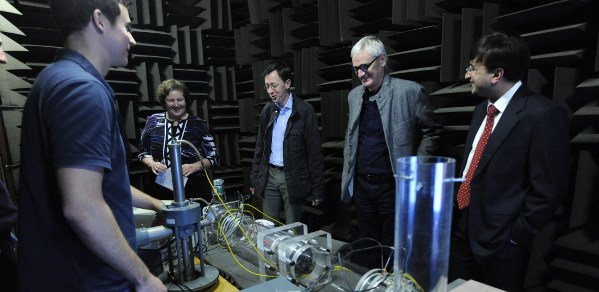
Dyson sponsored PhD student Tim Newman, has won First Prize in the Best Student Paper Award competition at ICA 2013 Montreal for his paper titled 'A six sensor method for measuring acoustic properties in ducts'.
We are interested in finding novel ways to 'move air quietly'.
PhD student Tim Newman
With 2300 registrants, over 1600 technical papers, and 49 exposition booths, ICA 2013 was one of the biggest meetings in acoustics ever. The technical program included papers covering all branches of acoustics. Dyson sponsored PhD student Tim Newman was awarded First Prize in the Best Paper Awards for students in his category. His paper was also published in Proceedings of Meetings on Acoustics (POMA) an online, open-access, proceedings journal from the Acoustical Society of America.
The aim of the project is to investigate air movement for high efficiency and low noise in the power range of small-scale (e.g. domestic) applications. It is part of a new and expanding collaboration between the Department of Engineering and Dyson Ltd, the UK manufacturing company. The Dyson Air Multiplier™ desk fan is used as the test case for a fan optimised for low noise. The product works by drawing air in through the base of the product and expelling it through a narrow ring-shaped gap in the hoop-like 'amplifier'. This annular jet of air entrains large amounts of surrounding air to flow through and around the hoop.
By looking at the components of the product in isolation, it is clear that the main noise source is the compressor in the base which drives the flow of air. Much of the noise is generated aerodynamically and contains broadband (like the sound you hear when you put your head out of a moving car window) and tonal components (as a result of the spinning compressor blades). Tim and his team want to understand exactly how the noise is generated and find ways to reduce the noise at the source. In order to do this, they have designed and constructed an experimental rig. This consists of the compressor at the centre of a pipe with a variety of instruments downstream and upstream of the compressor to measure its performance (e.g. efficiency). A key focus of the paper was the novel method developed to measure the sound emitted into the pipe. By combining the sound measurements from an array of microphones mounted internally on each side of the compressor, they were able to study the structure of the soundfield generated by the fan and isolate the sound sources from other effects such as reflections at each end of the pipe.
This differs from the internationally-standardised (ISO) method which relies on large so-called 'anechoic terminations' which absorb sound at each end to prevent reflections or echoes. The resulting ISO rig, as used at Dyson, is around 14 meters long whereas the experimental rig is around 2 meters long and fits comfortably inside the anechoic chamber in the lab.
An important feature of the experimental rig is that it is modular and adaptable. Furthermore, the sound measurement methodology can be applied to many air-moving sound sources in a pipe or duct. This makes it possible to use the research for other applications such as HVAC systems (Heating, Ventilation and Air Conditioning) common in buildings and vehicles. The collaborators on this paper were; From the Department of Engineering - Mr Timothy Newman, Dr Anurag Agarwal, Professor Dame Ann Dowling. From the Aero-Acoustic Research Team - Research, Design and Development (RDD) at Dyson - Dr Ludovic Desvard, Mr Ryan Stimpson

